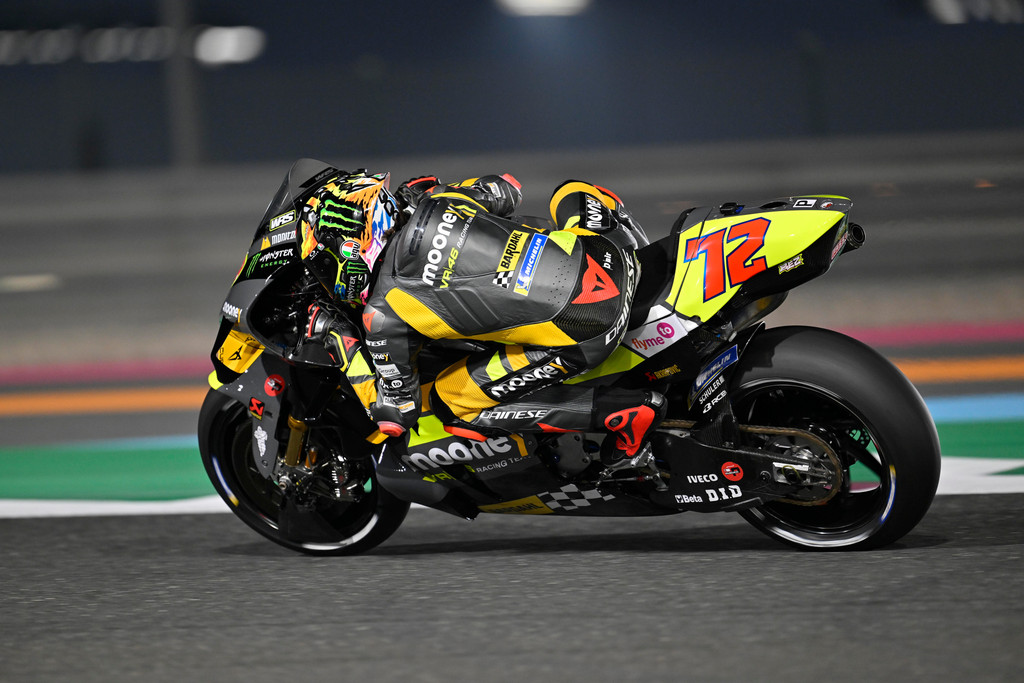Marco Bezzecchi officially debuted in the Moto3 class in 2017 and has been a professional MotoGP™ rider since 2022. Born in Rimini in 1998, he’s no longer dreaming about, but actually living out, a wonderful career. Gaining speed and victories in the minor classes, his three triumphs in Moto3 in 2018 and the 3rd place at the end of the championship stand out as his best results, together with other successes in Moto2 between 2020 and 2021, finishing 3rd and 4th in the championship standings. In 2022, he entered the premier class, and after a few tentative races he claimed a podium; the following year went even better – he immediately distinguished himself as one of the fastest riders and won the second grand prix of the season. Marco Bezzecchi has been a professional Dainese rider since his arrival in the World Championship: Here’s his racing suit from the 2022 season.
The base model is the Mugello RR D-air®, currently top-of-the-line in terms of protection for motorcycle racing. The Mugello RR D-air® worn by Marco Bezzecchi and other MotoGP™ riders integrates the same technical features as standard models, but is tailor-made for the rider to ensure a perfect fit and the optimal positioning and effectiveness of all protectors.

The most advanced protective device that distinguishes Marco Bezzecchi's Dainese Mugello RR D-air® motorcycle suit is the D-air® electronic airbag system. Introduced on the track in 2007 by Dainese, the electronic airbag revolutionized the concept of protection in motorcycle racing and became mandatory for all professional riders from the 2018 season onward. It’s a lightweight protector, totally integrated into the suit and almost imperceptible until it’s really needed, when it activates and inflates an air shield that protects shoulders and collarbones.
It works owing to the combination of an electronic ‘brain’ and an airbag. Through a number of sensors and an algorithm developed over twenty years, the former detects and analyzes the rider's movements 1,000 times a second, autonomously recognizing the initial dynamics of a fall and sending, when necessary and in advance of the fall itself, a signal to inflate the airbag.
The latter is one of a kind, owing to the patented microfilament technology that permits the air flow to be controlled inside the airbag and uniform thickness and pressure to be obtained over the entire surface. Accident detection and bag inflation are achieved in milliseconds. The D-air® control unit and gas generator are placed inside the hump, which is also equipped with an LED warning light that activates in the event of a fall, so as to make the rider more visible, especially in rainy conditions.
The D-air® airbag doesn’t merely provide protection. The suit integrates rigid composite protectors on elbows and knees, and soft ones on shoulders and hips. As well as the sliders, the titanium plates stand out on the outside of the suit, again on shoulders, elbows and knees, and they have a different function than the internal protectors.
The former’s task is mainly to absorb the impact force deriving from a fall and, constantly updated, they have been part of Dainese suits since the 1970s. The metal plates, on the other hand, were introduced in the early 2000s, and their role is to facilitate sliding, understood as the opposite of rolling – the worst-case scenario during a fall, since it causes further impact.
In some cases, rolling is due to materials that create friction against the asphalt and therefore stick to it. Metal – titanium in this case – is the best solution. It withstands high temperatures caused by rubbing without deteriorating and exerts less friction than, for example, plastic. Of course, you can't cover the entire suit with metal plates; it must be strategically positioned in the most exposed points and shaped so as not to affect the rider's freedom of movement.
In terms of freedom of movement, the role played by the Tri-axial stretch system positioned on the back, hips and shoulder blades is crucial. It’s a leather panel coupled with stretch fabric that extends in different directions, combining elasticity and abrasion resistance in a single element. In less exposed areas, such as inner arms, groin and back of the knees, a technical Kevlar stretch fabric is used. The lower part of the leg is designed to accommodate IN boots like the Axial D1 model.
Marco Bezzecchi's Dainese racing suit is much more than just a bunch of leather pieces sewn together. It’s packed with innovative technology developed and perfected over decades, starting with the D-air® system and ending with titanium protectors as well as seemingly simple, yet actually essential, elements such as the stretch panels. All this, in order to provide riders with the ideal conditions to express their full potential, without having to worry about anything other than the track and the motorcycle.